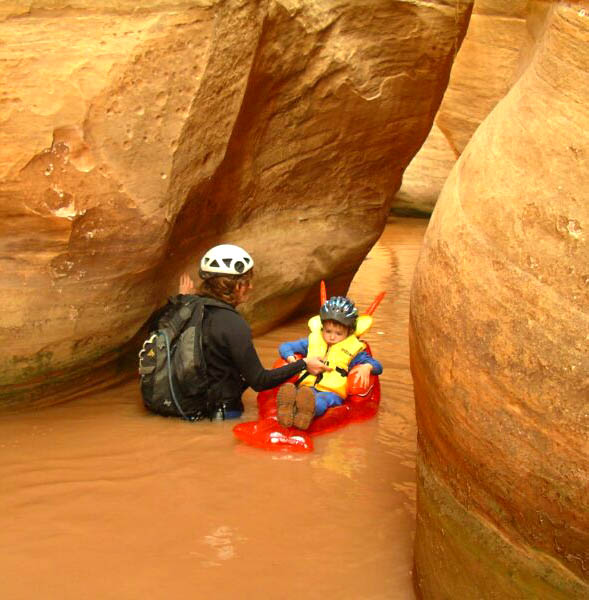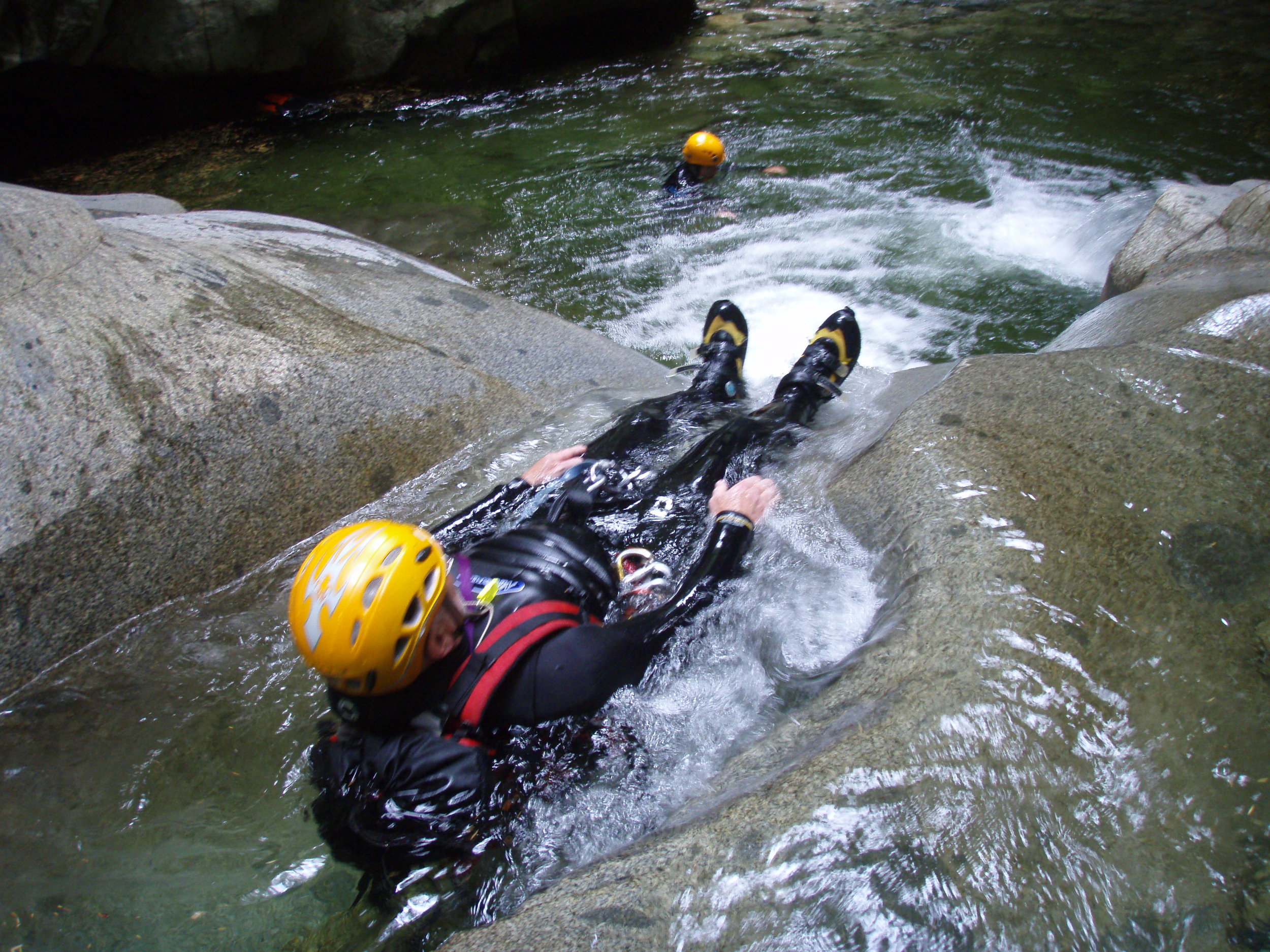
There IS a learning curve.
Canyoneering is a technical sport with serious consequences. I had the benefit of beginning my serious-technical-sport career as a young rock climber with good mentoring plus better luck, thus escaping injury, despite myself, through my clueless stage.
People become canyoneers via several different paths. This sometimes scares me because, as an old-fart trad climber, my foundational technical canyoneering skills come from technical trad rock climbing skills. Canyoneers who are not climbers are at a distinct disadvantage when the merde hits the ventilador. Especially when getting started, the most important technique is to seek out and canyoneer with knowledgeable veterans. Choose adventures within your abilities, while developing experience and expanding your skills.
When teaching beginners, we emphasize smart problem-solving as the primary skill to develop. Canyon problems are different, but similiar, to the problems climbers encounter on their adventures. I have a few notes here for beginners, and separate notes for climbers, who are venturing into the canyon world for the first time.
Technical Skills
Non-Climbing Beginners

Start 'em young
This young canyoneer already has four technical canyons under her belt, of course with the guidance of experienced leaders.
So How do I start doing more technical canyons safely on my own?
Well, actually, you don't. Several important aspects of technical canyoneering require a developed sense of judgment about elements like anchor quality, rock quality, and climbing difficulty. Problem-solving skills are best developed by canyoneering with experienced canyoneers. One of the nice things about canyoneering is it is not actually physcially difficult, so competent canyoneers can take unexperienced friends on canyon trips and everybody has fun.
Getting Trained
Canyoneering-specific training programs are very worthwhile, whether you are a complete bumbly or an experienced big-wall hardman. I learned more about ropework and rigging in a week with canyoneering instructor Rich Carlson than I learned in 20 years of climbing (including 2 ascents of El Cap). Canyon ropework is different than climbing ropework and, dare I say it, more advanced.
There are several guide services offering training in the USA:
Zion Adventure Company offers canyoneering training by experienced guides. A class with ZAC is a great way to get into the sport. They utilize canyons near Springdale, Utah as classrooms, which can make a great start to a Zion vacation. Technical gear is available for rent or purchase after your course, so you can go on your own. Call (435) 772-1001 to arrange an adventure.
In Escalante, Utah, Rick Green of Excursions of Escalante offers instruction in the fine art of canyoneering. Rick offers both individual mentoring and curriculum-based group courses. Get a hold of Rick at (800) 839-7567.
In the southeast corner of the state, Jared Hillhouse of North Wash Outfitters in Blanding, Utah offers curriculum-based instruction in canyoneering skills. Call (435) 678-3255.
We also have a more comprehensive list of guide services (and why you should consider a guide) on our Training and Guiding page.
While climbing instruction services can teach you some skills, few instructors know anything about canyoneering, which makes it hard to recommend them as the starting point for canyoneering. You can get comfortable on rope, and on rappel, with most any climbing instructor at rock climbing gyms across the country.
Do I really need training? Can't I just figure it out as I go along?
Canyoneering requires considerable improvisation and judgment. This really is a wilderness adventure. Rappels are often done using improvised anchors: trees, bushes, jammed rocks, stuck logs, spikes of rock, etc. Canyoneering rappels are often exceptionally awkward; wet, through narrow slots, often muddy, with difficult starts, with a pack on, into pools, off bad anchors and often with problems pulling the ropes. And the ropes have to be pulled, or the canyon cannot be continued. There is a saying in climbing that also applies to canyoneering:
"Good judgment comes from experience, and experience comes from surviving bad judgment."
Admittedly, many people just kind of went and figured it out as they went along, and most didn't die. Make it easier on yourself by finding people who already have it figured out, and tagging along with them for a couple of canyons, until you see how things work. One good place to meet new canyoneering partners is Canyon Collective. Put yourself out there and get invited on someone else's trip!
Technical Skills
For Climbers

A whole different animal.
For competent climbers, doing canyons is a lot like doing your first big wall, without the hard work of moving upward. There's a lot of rope management issues, new things to learn or figure out, and a fair amount of problem-solving. Once you've started down a canyon, there can be a sense of uncertainty about whether you are up to the challenges ahead. Canyoneering provides numerous opportunities to screw up, preferably avoided. The ability to yank your body up "License to Thrill" or some heinous crimp-fest does not help much. Except once in a while, when it REALLY helps.
I'm always amazed at how bad my competent climbing friends are at canyoneering. There are specialized skills needed for canyoneering, and those skills are developed by descending canyons. Climbers should spend some time doing 3A and 3B canyons before pursuing more committing objectives. The rating system is a big help: canyons with a technical rating of "3" are generally straightforward and trad-climbing ropework skills are usually sufficient. Canyons with a technical rating of "4" require canyoneering-specific skills.
Canyoneering: it's not climbing
Navigating pools while safely managing ropes and rappels is a canyoneering-specific skill. Just because someone knows how to climb does not make them a qualified canyoneer.
Examples of specialized skills needed for canyoneering:
Making sure the rope will pull. Canyon raps are not usually as clean as climbing descent rappels.
Rappelling on single and double strands, using thin and thick ropes, with light and heavy loads, wet and dry.
Rappelling into pools and disconnecting (without drowning).
Building natural anchors in difficult situations with few resources.
Having efficient ropework for multiple short rappels.
Multi-stage rappels - not pulling the rope until the next set of anchors is in hand.
Getting past keeper potholes.
Be especially cautious of canyons with flowing water and/or continuous potholes. Pothole escapes are one of the most technical aspects of canyoneering on the Colorado Plateau, and blowing it makes for skeleton soup. Practice such skills as pack tosses, partner climbing, and hooking - and have the right equipment when needed - in easier canyons, so you will know how to do them in the more difficult canyons.
The best way to develop canyoneering technique is to canyoneer with people who have been doing it for a while. With a good base of climbing skills, you are far ahead of non-climbing beginners.
Limited instructional information can be found in our Tech Tips section.




